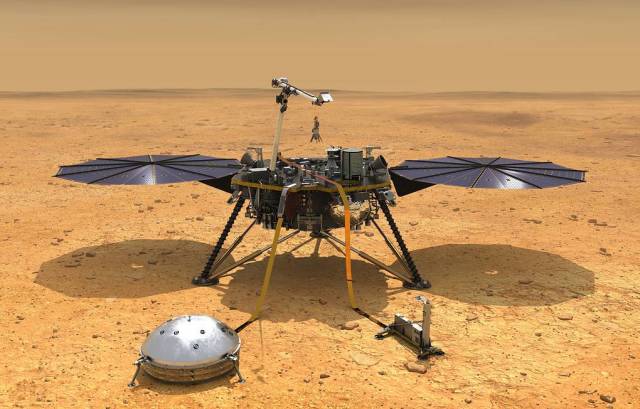Scientists believe that it was formed from 1.7 to 2 billion years ago
TASS, November 23. Thanks to seismic data collected by the InSight Martian lander, scientists have discovered traces of an ancient crater under a layer of frozen lava. The description of the work was published by the scientific journal Nature Communications .
"At a depth of 30-75 meters from the surface of Mars, we saw an unexpected anomaly. There was a loose layer of debris and sedimentary rocks, sandwiched between the deposits of basalt lavas of the Hesperian and Amazonian era," the researchers write.
The InSight lander landed on the surface of Mars in December 2018. It is designed to search for marsquakes and study the internal structure of the planet. Already in the first six months of operation, InSight recorded about 170 marsquakes. However, these data were not enough to compile a detailed geological map of the module landing zone.
In a new study, planetary scientists led by InSight mission scientist Bruce Banerdt circumvented this problem. They took advantage of the fact that the SEIS seismometer records not only tremors, but also "background" vibrations that arise as a result of the interaction of Martian winds with various irregularities of the planet's surface. As a rule, compared to marsquakes, it is much more difficult to notice such fluctuations. Nevertheless, the module's instruments can fix them.
These data showed that there are at least four layers in the depths of Mars in the InSight landing area. Two of them consist of basalts and other volcanic rocks, and two more are loose deposits of regolith, large boulders and other sedimentary rocks that are formed during the formation of craters or as a result of the movement of water flows. One of these layers is located at a depth of 30-75 m from the surface of Mars, in the gap between two layers of basalt.
Scientists assume that a loose layer of sedimentary rocks at such a great depth says that an ancient crater is located under the landing site of InSight, which hides a multi-meter layer of lava and sedimentary rocks. According to the researchers, it formed about 1.7-2 billion. years ago.
Banerdt and his colleagues hope that it will be possible to test this theory in the course of further observations of marsquakes and seismic "noise" of the planet.

